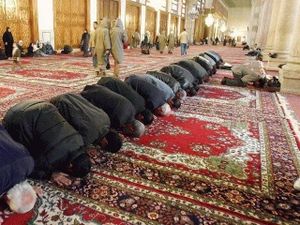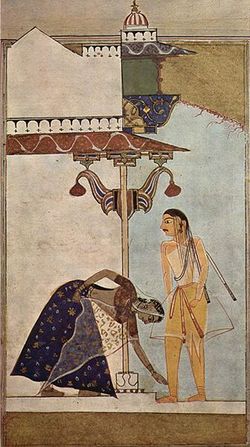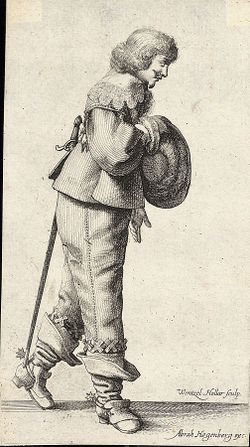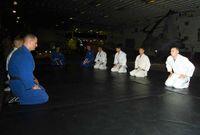Bow
Bowing (also called stooping) is the act of lowering the torso and head as a social gesture in direction to another person or symbol. It is most prominent in Asian cultures but it is also typical of nobility and aristocracy in many countries and distinctively in Europe. Sometimes the gesture may be limited to lowering the head. It is especially prominent in China, Korea, India, Taiwan, Japan, and Vietnam, where it may be executed standing or kneeling.
See also [ Bowing ]
Bowing in European cultures
In European cultures - aside from bows done by performers on stage, such as at the curtain call - bowing is an exclusively male practice, and females instead perform a related gesture called a "curtsey" or "curtsy." The depth of the bow is related to the degree of respect or gratitude. In European courtly circles, males were expected to "bow and scrape" (hence the term "bowing and scraping" for what appears to be an excessive ceremony). "Scraping" refers to the drawing back of the right leg as one bows, such that the right foot scrapes the floor or earth. Typically, while executing such a bow, the man's left hand is pressed horizontally across the abdomen while the right is held out from the body.
Bowing in Japan, Korea, and Taiwan
Bows are the traditional greeting in East Asia, particularly in Japan, Korea, Taiwan, and Vietnam. However, bowing is not reserved only for greetings. Bowing is a gesture of respect. Different bows are used for apologies and gratitude, to express different emotions, humility, sincerity, remorse, or deference, and in various traditional arts and religious ceremonies. Bowing has been a way to show respect people for a long time in East Asia.
Basic bows originate at the waist and are performed with the back straight and the hands at the sides (for men) or clasped in front (for women), and with the eyes down. Generally, the longer and deeper the bow, the stronger the emotion or the greater the difference in social standing.
Bows can be generally divided into three main types: informal, formal, and very formal. Informal bows are made at about a fifteen-degree angle and more formal bows at about thirty degrees. Very formal projections are deeper. In extreme cases, a kneeling bow is performed, which may be so deep that the forehead touches the floor. There is an extremely complex etiquette surrounding bowing, including the length and depth of bow, and the appropriate response. For example, if the other person maintains his or her bow for longer than expected (generally about two or three seconds), it is polite to bow again, upon which one may receive another bow in return, often leading to an exchange of progressively lighter bows.
Bows of apology and thanks
Bows are a required and expected part of any apology or expression of thanks in East Asia, especially Japan, Korea, and Taiwan .
Bows of apology tend to be deeper and last longer than other types of bow. They occur with frequency during the apology, generally at about 45 degrees with the head lowered and lasting for at least the count of three, sometimes longer. The depth, frequency and duration of the bow increases with the sincerity of the apology and the severity of the offense. Bows of thanks follow the same pattern.
Bows of apology are frequently performed at press conferences by high-ranking members of a company that has performed some misdeed, such as producing faulty parts that resulted in a death. These bows are almost invariably performed standing behind a table; the tips of the fingers touch the table while the upper body, held straight, is lowered from the waist until the face is parallel with the tabletop.
Bows of greeting
Bows are commonly used in greeting, both when meeting and when departing. Bows almost automatically accompany the greeting phrases, but generally are no longer used among the immediate family unless addressing a family member after or in anticipation of a long absence or separation.
Bows also replace speaking under certain circumstances. For example, when encountering again a person to whom one has already spoken that day, a silent bow replaces such phrases as "hello" or "hi."
A superior addressing an inferior will generally only nod the head slightly (some may not bow at all), while an inferior will bend forward slightly from the waist.
Bowing and shaking hands
When dealing with non-East Asians, many East Asians will shake hands. Since many non-East Asians are familiar with the custom of bowing, this often leads to a combined bow and handshake. Bows may be combined with handshakes or performed before or after shaking hands.
Generally when bowing in proximity to another, as necessitated when combining bowing and shaking hands, people turn slightly to one side to avoid bumping heads.
US President Obama, while bowed while meeting Akihito, Emperor of Japan at the Imperial Palace in Tokyo, but the quality of his bow became a topic of controversy because of the many ways the bow could be interpreted in an East Asian context.
Bowing in Mainland China
The kowtow was traditionally the highest sign of reverence in Han Chinese culture but its use has been extremely rare since the collapse of Late Imperial China. In many situations, the standing bow has replaced the kowtow. However, in modern Han Chinese societies, bowing is not as formalized as in Japan and South Korea. Bowing is normally reserved for occasions such as marriage ceremonies and as a gesture of respect for the deceased. In both the People's Republic of China and the Republic of China, three bows are customarily executed at funerals including state funerals, ancestral worship, and at special ceremonies in commemoration of pater patriae Sun Yat-sen.
As in Japan and Korea, public figures may bow formally to apologise. Chinese Premier Wen Jiabao bowed and offered his condolences to stranded railway passengers; Taiwanese Defence Minister Chen Chao-min bowed in apology for a gaffe concerning the shooting of former President Chen Shui-bian in 2004.
Bowing in martial arts
Bowing is an integral part of traditional martial arts. Bows are used to begin and end practice, sparring bouts and competitions, and when entering and leaving the dojo, or practice room.
Some martial arts bows are different in terms of the position of the arms and hands. For example, a karate bow is performed with the arms at the sides, while other bows--such as a Silat bow--are performed with the hands together and hands and arms in front.
Bowing in Tea Ceremony
Bowing is an important part of the Japanese tea ceremony. There are three main types of bow performed in tea ceremony; they are classified as shin (深). All are usually performed from a kneeling position. Shin bows are the deepest; from a kneeling position, the bower bends forward from the waist, placing the hands palms down on the floor in front of the body, with the fingers facing. Shin bows are performed to teachers and superiors. Gy" and s" bows respectively are less deep and less long. From a kneeling position and bowing from the waist, the hands are slid over the knees until the tips of the fingers touch the floor in front of the body. They are performed among persons of similar rank.
Students of the tea ceremony bow to each other and to their teacher; each class begins with bows between the teacher and students. If a senior student is teaching a junior student, bows are exchanged between the two. Before beginning a practice, a student bows to all the other students as well. This pattern is repeated when the practice ends.
A bow is performed at the door before entering the tea room, or tea house. One then proceeds to the tokonoma, or scroll alcove, and bows again. Finally one greets the teacher, and then the other students, or the other guests, with bows. This pattern is repeated when leaving the tea room as well.
The host of a tea ceremony bows before beginning the ceremony. Bows are exchanged repeatedly throughout a tea ceremony, between the host and guest of honor, among the guests, between guests and the hosts assistants, and between the host and guests.
Bowing in religious settings
Shinto and Buddhism
Bows are performed both in [[Shinto]] and Buddhist settings. Korean Zen Buddhism has a daily ritual in which practitioners do 1,080 full prostration bows, usually spread throughout the day. More casual practitioners and laypeople typically do 108 bows once a day instead.
Visitors to a Shinto shrine will clap or ring a bell to attract the attention of the enshrined deity, clasp the hands in prayer, and then bow.
Islam

In Islam, there are two types of ritual bowing, Sujud and Ruk'u. Sajdah is to prostrate oneself to God in the direction of the Kaaba at Mecca which is usually done during daily prayers (salah). While in sujud, a Muslim is to praise Allah and glorify him. The position involves having the forehead, nose, both hands, knees and all toes touching the ground together.
Ruk'u is bowing down following the recitation of the Quran in the standing position while praying according to Islamic ritual (salat). The position of ruk'u is established by bending over, putting one's hands on one's knees, and remaining in that position until the individual attains "calmness".
It should be noted that, in Islam, it is a sin to bow to anyone but God.
Christian liturgy
 Main article: Zemnoy poklon
Main article: Zemnoy poklon
In Christian liturgy, bowing is a sign of respect or deference. In many traditions, individuals will bow when passing in front of the altar, or at certain points in the service (for example, when the name of Jesus Christ is spoken). It may take the form of a simple bow of the head, or a slight incline of the upper body. A profound bow is a deep bow from the waist, and is often done as a substitution for genuflection.
In Eastern Orthodoxy, there are several degrees of bowing, each with a different meaning. Strict rules exist as to which type of a bow should be used at any particular time. The rules are complicated and are not always carried out in all parishes.
Conservative protestant Christians such as Brethren, Mennonites, and Seventh-day Adventists make a practice of kneeling during community prayer in the church service. Until the mid-1900s, this was common practice among all Protestant Christian groups.
According to the New Testament writer Paul, everyone on earth will someday bow to Jesus Christ. He writes in Philippians 2:9-11, "Wherefore God also hath highly exalted him, and given him a name which is above every name: That at the name of Jesus every knee should bow, of things in heaven, and things in earth, and things under the earth; And that every tongue should confess that Jesus Christ is Lord, to the glory of God the Father." KJV. He is here quoting a similar passage regarding bowing from the Old Testament, Isaiah 45:23.
Judaism
In the Jewish setting, bowing, similar to in Christianity, is a sign of respect, and is done at certain points in Jewish services. By tradition, in the Temple in Jerusalem, kneeling was part of the regular service, but this is not part of a modern Jewish service.
Some bows within the current liturgy are simple bows from the waist - others (especially during parts of the Amidah) involve bending the knees while saying Baruch (Blessed), bowing from the waist at Atah ([are] you) and then straightening up at Adonai (God). During the concluding Aleinu section of the services, congregants usually bow when they say "V'anachnu korim umishtachavim u'modim," meaning "we bend our knees, prostrate, and acknowledge our thanks." Another moment in the service which triggers the bow is during the "Bar'chu." Many bow at the mention of "Adonai" (the Jewish addressing of the Lord) at this and various other parts in the service (most likely if they are to remain standing during that prayer).[1]
Kneeling is retained in modern Orthodox Judaism, but only on the High Holy Days - once on each day of Rosh Hashanah (when the Aleinu prayer is recited during the Amidah), and four times on Yom Kippur - again, once for Aleinu, and three times during a central portion of the service when the details of the Avodah, the High Priest's service in the Temple are recited.
The Talmudic texts as well as writings of Gaonim and Rishonim indicate that total prostration was common among many Jewish communities until some point during the Middle Ages. Members of the Karaite denomination practice full prostrations during prayers. Ashkenazi Orthodox Jews prostrate during Rosh Hashana and Yom Kippur as did Yemenite Jews during the Tachanun part of regular daily Jewish prayer until somewhat recently. Ethiopian Jews traditionally prostrated during a holiday specific to their community known as Sigd. Sigd comes from a root word meaning prostration in Amharic, Aramaic, and Arabic. There is a move among Talmide haRambam, a small modern restorationist group with perspectives on Jewish law similar to that of Dor Daim, to revive prostration as a regular part of daily Jewish worship.
See also
References
- ↑ Hayim H. Donin, To Pray as a Jew, 1980; pages 38-41.



